Successful lawn maintenance contractors come in all shapes and sizes. That's one of the strengths of this industry. You don't have to be a conformist to succeed.
Large contractors, small contractors, those who operate intermediate walk-behinds and those who operate riders can be equally successful. Some choose to operate new equipment. Others like the idea of squeezing as much as they possibly can out of their "iron."
This doesn't mean, however, that anarchy reigns. How contractors operate depends in large part on the properties they maintain. And there is one fundamental rule, of course- you have to be profitable to succeed.
Over the years, Wayne Mansfield, owner of Nansemond Lawn & Garden, Suffolk, Virginia, has been profitable and successful. He started a lawn maintenance business in his hometown in 1983 because he thought there was a market.
Seventeen years later, he has a solid core group of customers, acts as a mentor to up-and-coming lawn maintenance contractors, and operates a business that generates well over $1 million annually, primarily in lawn and landscape maintenance.
Image Is Everything
If you've ever driven around the Chesapeake, Norfolk, Newport News or Virginia Beach areas, chances are you've seen a Nansemond Lawn & Garden crew outfitted with a 1-ton dump truck and 20-foot enclosed trailer. The crews alone will paint a pretty clear picture of Wayne's philosophical approach to business.
Crew members are neat and clean, truck and trailer are freshly washed, and the equipment, including the Walker Mowers, looks nearly showroom-clean.
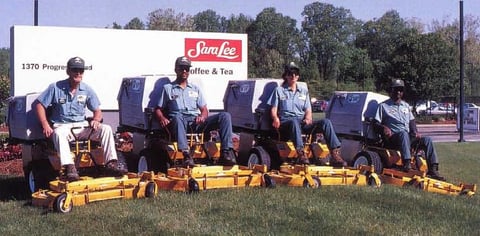 "I'm real big on image," Wayne tells. "With mostly commercial maintenance accounts, the selling point of my business is how I look. To corporate accounts, image is everything, which means that everything we do has to be image-oriented, from the equipment we operate to the dress code employees follow."
"I'm real big on image," Wayne tells. "With mostly commercial maintenance accounts, the selling point of my business is how I look. To corporate accounts, image is everything, which means that everything we do has to be image-oriented, from the equipment we operate to the dress code employees follow."
Sounds shallow? Not really, especially in an upscale corporate environment where first appearances leave lasting impressions.
Everything the company does may be image-oriented but it also has a pragmatic bent. I having 1-ton dump trucks, for example, gives each crew the ability to dispatch its own grass clippings and debris. In addition to keeping equipment clean and painting a good image, the covered trailers act as rolling billboards.
Wayne prefers full-service contract maintenance accounts to "mow and blow" properties. The former allow him to control the look of the property and his company's reputation. But they also are more profitable.
And despite the size of his operation - 35 employees, four lawn maintenance crews, four landscape maintenance crews and one installation crew - this owner often finds himself operating a string line trimmer or mower. Doing so leaves a lasting impression with employees who appreciate an owner who is not above doing the things he asks them to do. It also gives him an opportunity to check on properties and the performance of his crews.
The company's Walker Mowers have form and function, as well. Wayne purchased his first one in 1992 because, he says, crews did a lot of manicure-type mowing. Nothing compared to the Walker's cut and bagging capability.
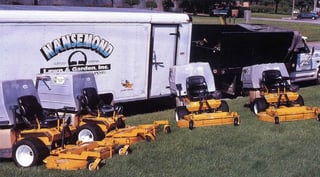 But since then, he has found the mowers to be "time savers, and "inexpensive to operate." In fact, today crews operate four 20-hp Walker Mowers with 48-inch GHS decks. The mowers are responsible for the lion's share of the 6 million square feet of grass the company mows each week. Crews also operate Ransomes riders for wide-area mowing. The Walkers took the place of their intermediate walk-behinds.
But since then, he has found the mowers to be "time savers, and "inexpensive to operate." In fact, today crews operate four 20-hp Walker Mowers with 48-inch GHS decks. The mowers are responsible for the lion's share of the 6 million square feet of grass the company mows each week. Crews also operate Ransomes riders for wide-area mowing. The Walkers took the place of their intermediate walk-behinds.
"When my dealer left that first Walker for me to try out, I just couldn't get used to not having a steering wheel," Wayne remembers. "I was raised on our family farm and was comfortable with riding mowers with steering wheels like tractors had. So I asked the dealer to take it back. But he was persistent and left another. This time I became convinced I needed it for its bagging capability."
Now steering wheels are nearly a thing of the past for company mowers, except for one garden tractor - a requisite for an employee who just can't get used to the idea of steering with levers.
Today, this owner still thanks his dealer for being persistent. He also understands that equipment is only as good as the dealer and the manufacturer that stand behind it. "I can't imagine a better dealer than Scott Dodson, owner of Turf and Garden in Chesapeake," Wayne emphasizes. "He takes care of me when I need him, no questions asked."
Being Comfortably Uncomfortable
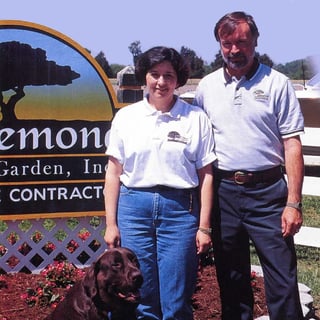 Wayne operates Nansemond Lawn & Garden with his wife Susan who spends most of her day taking care of the "business end" of the operation. For more than 18 years, she juggled the business while operating an antique shop, the essence of which still flavors the office and the shop area.
Wayne operates Nansemond Lawn & Garden with his wife Susan who spends most of her day taking care of the "business end" of the operation. For more than 18 years, she juggled the business while operating an antique shop, the essence of which still flavors the office and the shop area.
Antique toy tractors and trucks, along with other memorabilia, share her spacious office. Outside, a neatly maintained service shop with its old fashioned gas pumps conveys a more laid-back '50s atmosphere, one that partially disguises the frenetic pace of a lawn and landscape operation.
Out of the antique business for two years, Susan says she would never have time to run both operations today. The lawn maintenance business has grown that much, even over the last two years.
Susan and Wayne attribute their recent expansion to the area's overall growth, and their reputation. Last year, they received the First Annual Norfolk Arbor Award and won First Place Commercial Keep Virginia Beautiful Award.
The company is also more involved in landscape installations. In fact, last year they retained a full time landscape architect who now spends most of her time generating computer-enhanced designs for high-end residential accounts.
"The computer images are great selling tools," tells Wayne. "Our designer will take a digital photo of a property, and then place it on the computer with the proposed plant material and hardscape in place. It gives a customer a good feel for what a final design will look like upon completion. Even if we don't sell them on the entire project, we recommend they start with a full design and then, if necessary, complete it in stages."
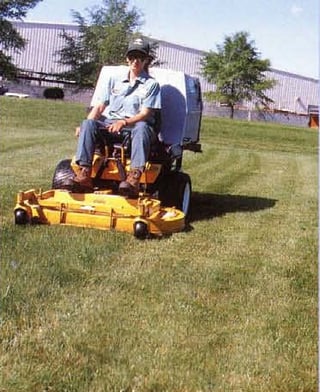 Although landscaping and maintenance complement one another, the Mansfields see their greatest future growth to be in landscaping. Landscape installation and design is profitable and less labor-intensive than maintenance, which is more labor-challenged than ever thanks to today's employee crunch.
Although landscaping and maintenance complement one another, the Mansfields see their greatest future growth to be in landscaping. Landscape installation and design is profitable and less labor-intensive than maintenance, which is more labor-challenged than ever thanks to today's employee crunch.
In fact, did Wayne mention the other reason he will at times find himself operating equipment in the field? To fill in for an employee no-show. It happens, he says, no matter how long you've been in business or how good your employees are. Still, maintenance is important, Susan adds, because it keeps the cash flowing year-round.
Ideally then, the couple would like to keep their maintenance business at or near its current level, and concentrate a little more on landscaping. Yet, there is a hitch to no growth, particularly when your maintenance accounts are larger commercial properties.
If a property is lost, so goes a large chunk of revenue stream. "The key is to always operate in the uncomfortable range," tells Wayne. "You always need to be stretched a little with equipment and employees. Then, if you lose a big account, your overhead won't be out of proportion."
Sounds like good advice for any size contractor. And it's probably part of the form and function mini-lecture Wayne gives new contractors who come in asking for advice. He will also talk a little bit about image, and about equipment, which is probably one reason why more and more contractor trailers in the area are hauling around Walker Mowers.



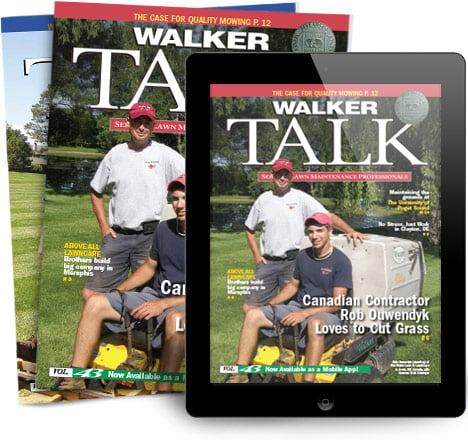
 Site Search
Site Search



